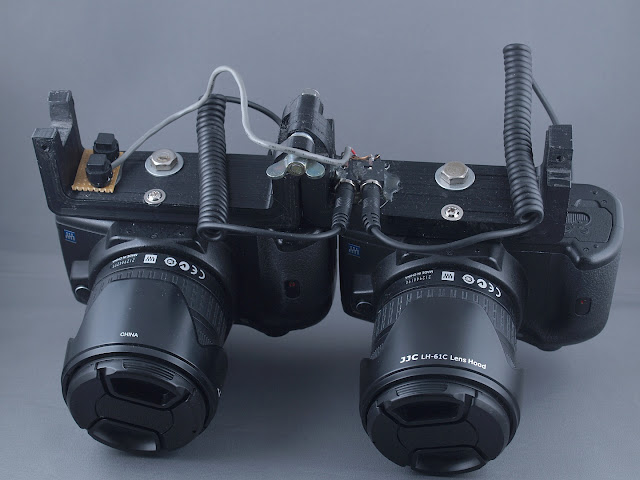It could get expensive, needing two cameras with the same lenses, but by using obsolete 2nd hand gear, I was able to keep it affordable.
Using a pair of OM-2SPs plus winders on a simple horizontal bar worked well, and still would if I were to source some film and resurrect that rig, which I could do since I still have all the parts.
In the digital age, I replaced the film cameras with a pair of Minolta A-1s (when they were several years old and therefore inexpensive). Once again, it was possible to use a simple lead which connected the pins on one socket on the back of one camera to the same pins on the corresponding socket of the second, allowing the shutter release button of one camera to control both cameras. Sadly, one of the A1s succumbed to the infamous sensor defect, and, even more sadly, did so after Sony had stopped replacing the defective sensors FOC.
So I gave up stereo photography until earlier this year (2019), when I noticed that very affordable Olympus E-600s had started appearing on eBay. It looked like the same method of linking them would work, they're very compact for digital SLRs and I had an idea about 3-D printing a bracket that would allow me to switch from landscape to portrait orientation at will. A working prototype of the rig is shown below in portrait orientation. I'm calling it a working prototype because it does work, although a few things could be improved for the next attempt. It hinges around the bolt at the top with the wing nut. The two small screws to the right of the wing nut allow a bit of adjustment of the alignment when they are horizonal.
The coiled cables are adapters for a multi-function cable release & timer, which can be bought separately from the device itself. It was either that or buy a couple of cheap cable releases and cut off the cables.
Here's the view from the back, showing the cables plugged into the cameras' multi-function ports. The cables came with 3-way 3.5mm jack plugs on their other ends, which I plugged into a pair of sockets that you can see in the top-right corner of the camera bracket. I was hoping to be able simply to connect these together and use either of the cameras' release buttons to trigger both cameras, as with the previous arrangements, but this turned out not to be possible for reasons I've not been able to fathom. A bit of poking around with a test meter revealed that two of the jack terminals have small positive voltages relative to the third, and connecting one of those to the 3rd terminal activates the autofocus & metering system (i.e, that's equivalent to a half-press of the shutter release) and connecting both to the 3rd terminal releases the shutter (i.e. a full press of the shutter release). using a couple of diodes to isolate the cameras from each other and using a pair of momentary action push buttons (bottom-left corner of the camera bracket) allowed for triggering both cameras at once. It's not the most ergonomic solution possible, but it works.
Above is the whole thing in landscape orientation. You can probably tell from this that the 3-D printing had some bed adhesion issues, but it didn't detach completely and has turned out to be useable as it is. That's the other main area of improvement for the next version, along with devising some way of adjusting the cameras' alignment.
Finally for now, some stereograms. These are all red/cyan anaglyphs (i.e. you need glasses with a red filter over the left eye and a cyan filter over the right eye) and mostly monochrome. Firstly, we have here a picture of my old OM-1
I'm rather pleased with this, despite the front of the lens not looking quite right, since it was taken with flash lighting at 1/100 s, triggered from the right-hand camera. I find that pleasing because the cameras need to be synchronised to within about 1/250s for that to work properly - otherwise the left-hand camera would have a dark band at the top or bottom of the image where the shutter either hasn't finished opening yet or has started closing already.
Secondly, here are some pictures around my place of work:
https://photos.app.goo.gl/4YNHieqRQwKkpzF48
And here are some taken at a gig:
https://photos.app.goo.gl/nfXSwmFnyUm8N9Rq9















